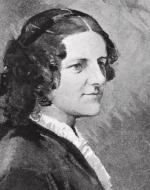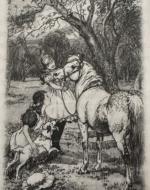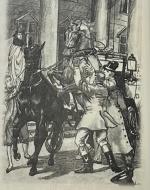Created by Lorelei Heuer on Tue, 10/15/2024 - 11:30
Description:
‘We call them dumb animals, and so they are, for they cannot tell us how they feel, but they do not suffer less because they have no words. My doctrine is this, that if we see cruelty or wrong that we have the power to stop, and do nothing, we make ourselves sharers in the guilt.’ -Anna Sewell
Black Beauty is a story to educate all on Anna Sewell's message that we must protect animals and treat them well. Sewell's novel brought awareness about the treatment of horses and prevented horse cruelty. Every page is filled with these lessons, and it tells the stories of many horses, with chapters centered around their life struggles. This book is sure to prompt sympathy and make all who read it consider the feelings of animals. The anthropomorphic protagonist asserts connection.
Cover of Black Beauty by Anna Sewell, Illustrated by Lucy Kemp-Welch, 1915. Anna Sewell's Black Beauty is a beloved story that has been appreciated since 1877 for its timeless significance and empathetic story telling. The story is from a first person perspective of the horse protagonist, Black Beauty and follows him as he is relocated multiple times due to changing circumstances. The qualities of the humans with power over Beauty and other horses, and the way they may abuse this power reflects the theme of the children's novel. Those who are truly good are good to all of God's creations which means treating animals with compassion. Sewell places value on the morals of Christianity as we can see in the distinction between right and wrong. Like all didactics, goodness is praised and sinning is punished. Sewell says the purpose of her writing in the novel is "to induce kindness, sympathy, and an understanding treatment of horses." The personification of Beauty emotionally connects children to the horse, allowing them to develop empathy for animals and understand why the mistreatment of animals is wrong.
Portrait of Anna Sewell (1820-1878), Wordsworth Editions. The portrait is of the author of Black Beauty, Anna Sewell. Sewell was born in 1820 in Yarmouth, England. At the age of fourteen she broke her ankle, which permanently disabled her and put her in bad health for the entirety of her life. Because of her mobility issues, she relied heavily on horses for transportation, developing her connection with them and sympathy for the mistreatment of the creatures. Later her health conditions worsened and she was bedridden, which motivated her to put her efforts into writing about a Victorian issue she was passionate about: the cruel treatment of horses and disregard for their well-being. Her work was incredibly influential in creating change in the working conditions of horses. Her writing describes the pain that horses experience in the ‘bearing rein’ which was used for fashion and just that. The blinker was also criticized by the horses in the book, as they agreed that blinkers cause more accidents because of the obstruction of their view. It is this understanding of the effect of the instruments used to control them that allows Sewell’s compassion to become contagious, and therefore Black Beauty is a transformative work that influenced owners to be more mindful of how they treat their horses.
Lucy Kemp-Welch, "My Mother and I," for Black Beauty (1877), by Anna Sewell, 1915 edition. Beauty's story begins in a pasture with his mother as shown in the above illustration. The pastoral illustration is a pleasant memory of domestic bliss, which Sewell includes to show young readers the horse's joy in the freedom of the initial setting. Beauty is fond of his home, spending his days alongside his mother and playing with other colts in the field. When the colts play rough, kicking and biting, Beauty’s mother Duchess interjects with moral instruction. She reminds him that he is well-bred and should be well-mannered, gentle, and hardworking. With those favored qualities in Victorian children highlighted we can see the didactic influence immediately in the story. This lesson is forever ingrained in Beauty, and though later he may face cruelty at the hand of man, he remembers to keep his temper and do his best despite his circumstances. This distinguishes Beauty from other horses who become jaded or 'spoiled', for his gentle upbringing in his first two homes reflect well on his masters and make him more desirable. The horse benefits greatly from heeding his mother's advice on life, and it is a lesson to children that listening to one's mother will preserve good character.
Lucy Kemp-Welch, "In the Orchard," for Black Beauty (1877), by Anna Sewell, 1915 edition. The illustration "In the Orchard" depicts the horses good relationship with the ladies of the household. It shows the peace that comes with their good treatment under their master Squire Gordon. However, the animal element past experiences and the ongoing sufferings of animals in many places. The animals of Beauty's talk about how modifications to their body are made “for fashion” “...‘just as if the good God that made us did not know what we wanted and what looked best’,” (Sewell 26). One horse says, “‘What right do they have to torment and disfigure God’s creatures?’” (Sewell 27-27). This is the moral of the entire story. A bitter feeling rises in Beauty because though he had not yet experienced cruelty, hearing the stories of the other horses upset him greatly, because as said, none of God’s creatures should be treated that way. There is no reason for cutting dogs' tails to make them plucky and shearing their ears to make them sharp, other than fashion. One horse named Sir Oliver, has a very short tail which he said was cut “through the flesh and through the bone,” (yes, horses have bones in their tails, it is part of their spinal column) which is both horribly painful for them but also prevents them from being able to brush the biting flies that sting him. Another critique is the use of blinkers, as the horses discuss how dangerous they are and how many accidents wouldn’t occur if not for their use. All of these modifications, as said, are an insult to God, as all of his creatures are made with purpose, and each body part made with clear intention to benefit the creature, which we all know. This dialogue calls out these cruelties of humans, and acknowledges pain that afflicts them through these actions. Sewell wants to make people aware of the consequences of their actions, because if animals could speak, that is what they’d say. Sewell’s points of God would cause a feeling of guilt in Victorian hearts; Sewell reflects their cruelty as very unchristian like and her saying it directly goes against God has a big impact among Christains. The use of religion to drive home her point has didactic influence, similar to the ones commonly read in those times that use Christianity to instruct on what is right and wrong. Good Christian men carry on this message to others, like the kind and gentle John, who catches a boy whipping and kicking his horse because it could not jump a gate too high for him. "Then he talked to the boys very seriously about cruelty, and said how hard-hearted and cowardly it was to hurt the weak and helpless; but what stuck in my mind was this, he said that cruelty was the devil's own trade-mark, and if we saw any one who took pleasure in cruelty we might know who he belonged to, for the devil was a murderer from the beginning, and a tormentor to the end. On the other hand, where we saw people who loved their neighbors, and were kind to man and beast, we might know this is God's mark." (Sewell, 36). This book is meant to call out the hypocritical Christians who ignore God's instruction to be kind to all, and though 'love thy neighbor' is a well known doctrine of Christianity, many people did not think to extend it to animals as well. It is not just those who commit acts of cruelty that are wrong, it is also those who are complacent in mistreatment. The men in this story who stand up for horses, interefering when there is evil, are distinguished as very good people. Sewell encourages everyone to interfere when they see wrong being done, because it is everyone's business that harm does not come upon the innocent.
Lucy Kemp-Welch, "They Both Flew to Her Head" for Black Beauty (1877), by Anna Sewell, 1915 edition. Over the course of the novel Beauty passes through many hands, and some are cruel or ignorant. Ignorance is highlighted as being just as bad as purposeful cruelty, because it still causes the same harm, but only with the excuse of 'I didn't know'. When Beauty work to carry different people for his new job, many are very uninformed about horses and their ignorance causes harm to the horses or themselves. Sewell wants to address that horses are not like machines or inanimate objects, and even these you must care for so they do not break down. The aforementioned 'fashion' later causes Beauty great strain and depression when he has a lady who will not heed the warning of the man to let them raise their heads by increments. This is the check-rein, which is a harness that prevents the lowering of a horses head, and it is done by shortening the rein so the head is held higher. This was the fashion of London, but it causes pain to the horses and will ruin them much quicker and shorten their lifespan. In the image, Beauty's companion Ginger, another Beauty asks another horse if their masters know the harm it causes, and the other horse answers that he cannot say but he knows that horse dealers and horse-doctors know it very well because they see it so often. They do nothing to prevent the cruel lives horses will be sentenced to.






